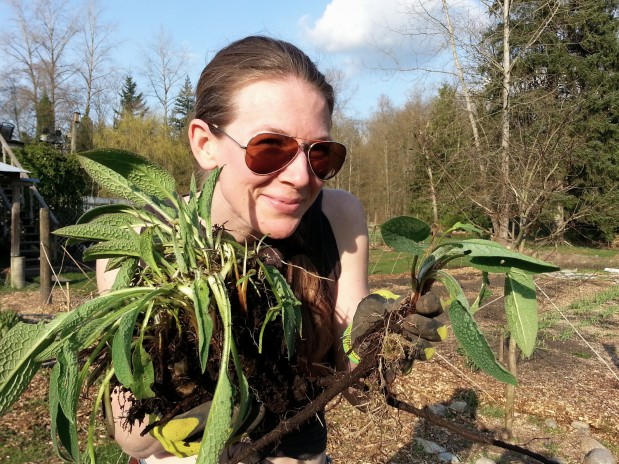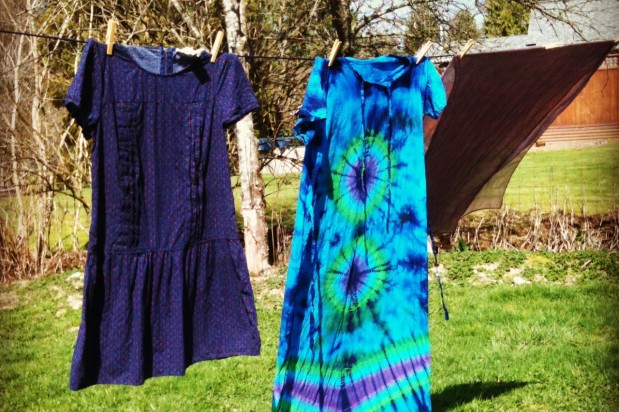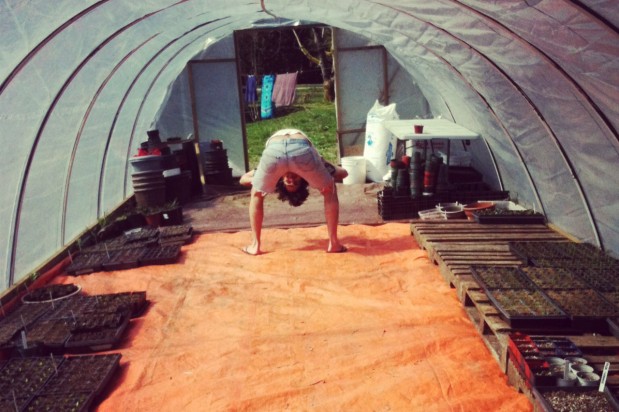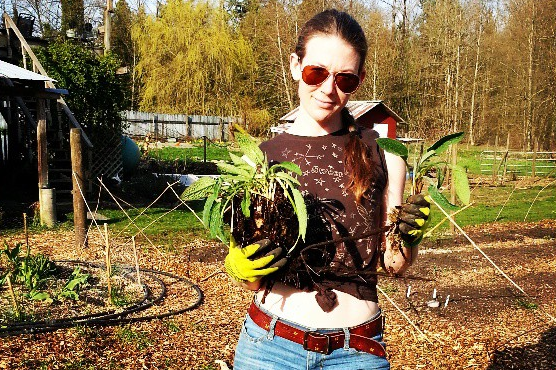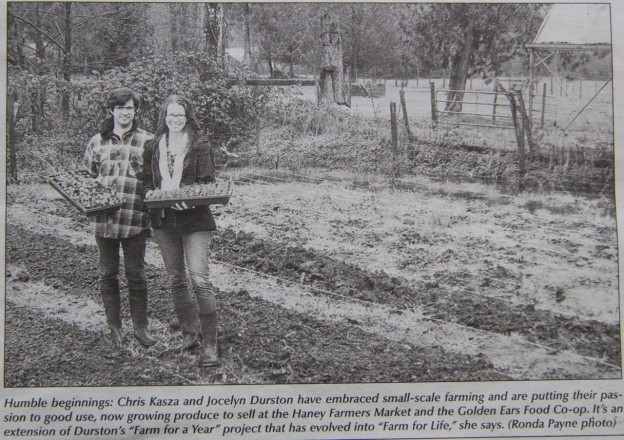 For the second time in two years, writer Ronda Payne has written an article about our farming project. The first article was an interview with myself about the original ‘Farm for a Year’ project. Almost a year and a half later, Ronda returned to interview both Chris and I about our move into the market gardening business. The article isn’t online, so I’ve reprinted it here for readers. Thanks again Ronda for helping us share our story!
For the second time in two years, writer Ronda Payne has written an article about our farming project. The first article was an interview with myself about the original ‘Farm for a Year’ project. Almost a year and a half later, Ronda returned to interview both Chris and I about our move into the market gardening business. The article isn’t online, so I’ve reprinted it here for readers. Thanks again Ronda for helping us share our story!
Small scale ag experiment morphs into Farm for Life
by Ronda Payne
Country Life in BC, April 2013 Issue
MAPLE RIDGE – Small scale farmers are proving they can make, and are making, a difference in the push for food sustainability and local agriculture. In 2011, an ambitious “Farm for a Year” project in Maple Ridge saw a handful of young adults, relatively inexperienced in agriculture, feed their families while learning and applying a variety of farming tactics.
Now, well past the one year end point, a number of things have changed but the drive to continue learning and farming locally has persisted. The farm continues to be an educational environment with a number of students from pre-school to adult eager to learn about farming methods and practices.
With an expanded land base under production, the team is growing produce to sell at the local Haney Farmers’ Market (special opening April 20, regular markets start the first Saturday in May) as well as to support the fledgling Golden Ears Food Co-op.
“Our priority will be to sell at the farmers’ market where we can interact directly with our customers and get top dollar for our produce,” says Jocelyn Durston, who was responsible for the original proposal to farm the two and a half acre hobby farm her friends live on. “But we will definitely be interested in supplying the co-op with fresh produce as our supplies allow.”
As Farm for Life evolved, group members changed. Durston, her childhood friend Julie Clarke and Clarke’s husband, Chris Moerman, stayed involved. The couple’s young son Kai is continually learning the ways of farming. A new member, Durston’s partner, Chris Kasza, also came on board.
“Our common interest in permaculture is what brought us together,” notes Durston of her relationship with Kasza and his ultimate arrival on the farm.
Kasza has been an instrumental addition due to his extensive permaculture and master gardener education. He and Durston take on the lion’s share of the work in keeping the farm operational and participation in production gardening is theirs alone.
“The market garden is just Chris and I,” Durston says. “Chris (Moerman) is primarily interested in the fruit trees and the perennials.”
The arrangement is ideal. Durston and Kasza have modified their lifestyle to allow for more time to manage farm activities. Moerman and Clarke balance off-farm jobs with contributing as much as they can to the growth and advancement of the farm which includes the orchard, production gardens, animals, herbs and a healthy dose of permaculture-based planning.
In fact, Durston and Moerman recently signed up for a 14 month Permaculture Design Course (PDC) certification to further their understanding of how plants work together to create a more positive environment for growing.
With the move to join the farmers’ market, more land was needed. One plot was obvious – a location Kasza had already been using. The second, another off-site plot of raised beds, is the sunniest region of the combined acre under production, but for off-site production, planting had to be carefully considered.
“What we plant there took big thought,” notes Kasza. “We can’t get there every day in the summer.”
Other changes on the farm have included the rabbits becoming pets rather than a meat source and the chickens and ducks being used for egg production as well as pest control.
“Muscovy and Indian runner ducks are the best at eating slugs,” Kasza says. “The Indian runners are less interested in the destruction of the plants.”
The small orchard has moved, and a polytunnel greenhouse was erected. The poly was not the first choice in material, but it was a necessity with its position on top of a new septic field.
“We had to be sensitive to the fact it was over the septic field,” says Durston about the choice of materials, methods of construction and weight.
When asked what visitors to the farmers’ market can expect, the response was a list of standard vegetables, but according to the pair, that’s what people are asking for.
“People were looking for specific classic items, like carrots,” comments Kasza.
That doesn’t stop them from doing a few unique things like including edible flowers in their mixed salad greens. There is also a healthy dose of exploration.
“We suffer from a broad interest in trying new varietals,” Kasza jokes.
“Farm for a Year became Farm for Life about a year and a half in,” explains Durston. “It became apparent that I wasn’t leaving. It is our second year selling at the market (and operation a small production garden). It’s interesting; I want to grow food for life, but I also want to grow food in a life giving way to improve food sustainability and availability.”
